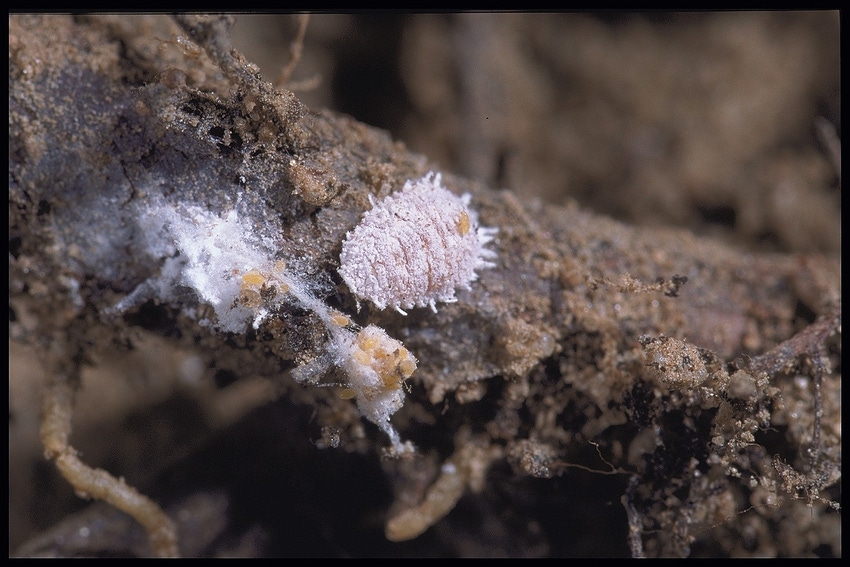
The threat to vineyards from vine mealybugs isn’t one to be taken lightly. Just ask growers in the San Joaquin Valley who faced heavy pressure from the grape-infesting pest last year.
They include those in Fresno County. “Growers and PCAs here reported a tough battle in some vineyards suppressing vine mealybug populations,” says George Zhuang, the county’s University of California Cooperative Extension viticulture farm advisor.
“In 2016, we saw heavily-infested grapes in some vineyards that suffered significant losses of fruit yield and quality,” he says. “Vine mealybug is an additional concern for wine grape growers because it is the vector of grapevine leafroll associated viruses (GLRaVs), which can reduce yield, delay fruit maturity and lower wine quality.
“If you had heavy mealybug populations and damage in 2016, you should be considering your strategy early this year to prevent crop damage.”
Zhuang and UCCE entomologist Kent Daane describe how growers can manage the vine mealybug threat to reduce spread of the insect and the damage it can inflict on a vineyard in the Winter, 2017, issue of Vit Tips, the UCCE San Joaquin Valley viticulture newsletter.
Early scouting and controlling the population before it gets into the fruit are critical to success in limiting vine mealybug damage, they say.
The vine mealybug overwinters on the lower sections of the vine underneath the bark of the trunk where the eggs hatch. In Fresno County, that occurs in early spring underneath the bark. Often the insect isn’t noticed until the population increases, and the insects begin moving up from the trunk to the cordon and shoots.
They don’t all move at once. Although the vine mealybug population increases in spring and early summer, when much of new generation moves to the leaves and clusters as the vine matures, there are always some mealybugs that are still on the vine trunk, Zhuang notes.
The vine mealybug produces honeydew that covers the bunches and other vine parts and provides a support for black sooty mold to develop. “Typically, growers notice the honey dew and sooty molds when the vine mealybug has already fed on the leaves and clusters,” he says. “But, in heavy populations, the trunk can have a wet appearance even before the population moves to the leaves. After harvest, the vine mealybug population again accumulates on the trunk and even the roots, just below the soil surface, where the insect overwinters.”
Although this pest does not walk quickly or far, it does move between vines and even between vineyards. The wind and birds, as well as transporting equipment, like harvesters and shears, and fruit, pomace, canes and leaves contaminated with the insect can also spread the vine mealybug.
So, Zhuang notes, the first step in managing this threat is to monitor your vineyard for the presence of the vine mealybug.
One way is to set out pheromone traps, such as a red delta trap, baited with a synthetic vine mealybug sex pheromone to attract the insect. “This technique is most useful when you don’t have any mealybug in the vineyard and you’re trying to monitor for new arrivals,” Zhuang says.
He recommends placing them on the edges of the block near the road or adjacent vineyard. Two should be enough for a small vineyard, while two traps for every 80 to 120 acres should be used in larger vineyards.
In the San Joaquin Valley, he advises putting the traps up in June to coincide with the first significant flight of the male vine mealybug and then monitoring the counts of male adults on a biweekly basis. Flights peak in the San Joaquin Valley from August to October.
Although the number of male mealybug catches is important to identify the presence of vine mealybug, the count is of less value in determining density of vine mealybug population.
If you had considerable vine mealybug damage last year, assessing population size visually this year may be more useful than pheromone trapping to follow development and increase of the insect numbers, Zhuang says.
“It’s easy to do, and training a field crew to identify the signs of vine mealybug feeding is the most efficient way to detect the pest,” he says. “Having the field crew trained and scouting during the pruning, leaf removal and harvest stages can help to spot and mark the infestation areas and treat them after harvest or the next season.
A large amount of dark, wet-looking honey dew on the trunk and cordon and active movement of ants along the trunk are good indicators of a vine mealybug infestation, he notes.
Posters showing how to identify the vine mealybug are available through http://cesanluisobispo.ucanr.edu/Viticulture/Vine_mealybug/ or by contacting your local farm advisor.
In their article, Zhuang and Daane also describe how ant control, mating disruption and insecticides can be used to reduce vine mealybug populations. The article and free subscription to Vit Tips is available on the UCCE Fresno County website, http://www.cefresno.ucanr.edu/ – in the Newsletters menu.
More information on the vine mealybug can be found at http://www.ipm.ucanr.edu/
About the Author(s)
You May Also Like




